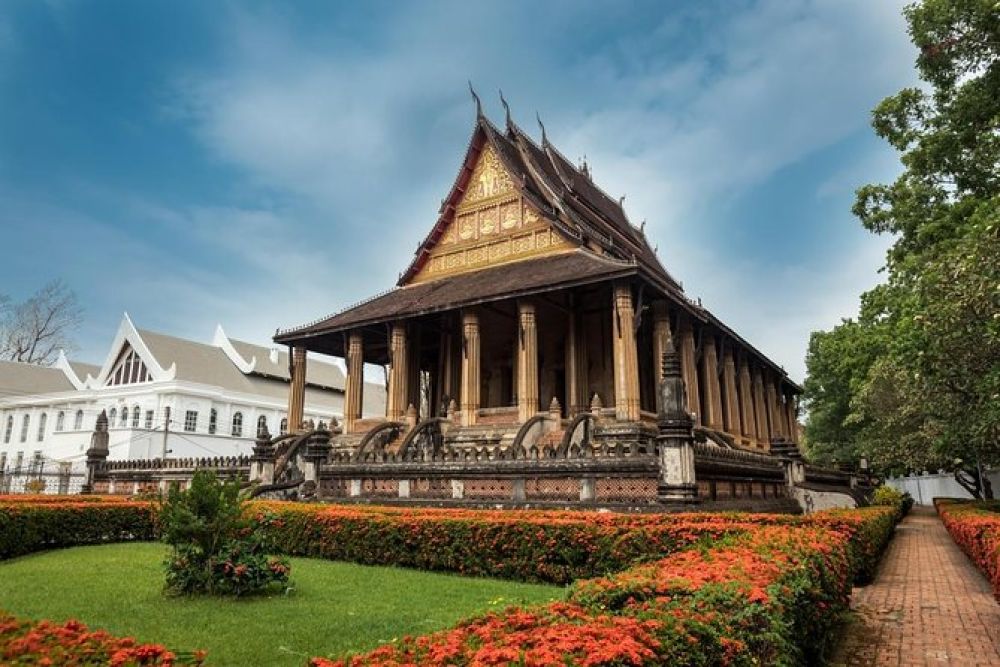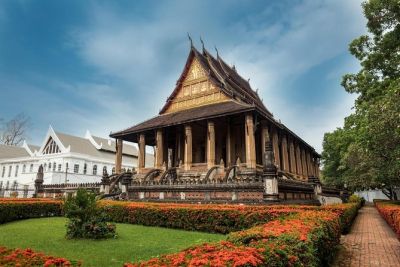

Wat Ho Phra Keo, also known as the 'Temple of the Emerald Buddha', is one of Vientiane's most cherished historical sites. Visitors can roam the serene temple grounds, absorbing the tranquil atmosphere and appreciating the Lao architecture. The temple, originally built in 1565 to house the famed Emerald Buddha, is now a museum showcasing a collection of Lao religious art. As you meander through, observe the intricately carved wooden doors, the gilded throne, and numerous Buddha statues in different poses representing various days of the week. The temple's history is captivating, having been destroyed and rebuilt multiple times due to conflicts with neighboring kingdoms. Today, it stands as a testament to Lao culture and resilience. Exploring the grounds is an immersive way to understand the country's spiritual heritage and the significance of Buddhism in Lao society.
Wat Ho Phra Keo serves not only as a spiritual landmark but also as a splendid backdrop for photographers keen on capturing the essence of Laos's rich cultural tapestry. The compound's detailed architecture, vibrant gardens, and the colorful rituals make for captivating photographic subjects. Enthusiasts and professionals alike will find delight in the intricate details of the temple structures, such as the carved wooden panels and the beautifully adorned naga staircases. The play of light and shadow in the early morning or late afternoon offers ideal conditions for stunning photo opportunities. Visitors are reminded to be respectful and unobtrusive, especially if there are worshippers present.
For those looking to immerse themselves in local spiritual practices, attending a traditional Lao ceremony at Wat Ho Phra Keo can be a profoundly moving experience. Depending on the lunar calendar and religious schedule, you may chance upon ceremonies such as the 'Baci', which is meant to call back one's spirits to the body, ensuring health and well-being. The 'Tak Bat', or alms giving ceremony, is another event that visitors can respectfully observe or participate in, typically held in the early morning. Visitors watching or joining these ceremonies should dress modestly, covering shoulders and knees, and follow the guidance of locals to maintain the decorum and sacredness of the event.
To truly grasp the intricate history of Wat Ho Phra Keo, joining a guided historical tour is highly recommended. Knowledgeable guides will provide valuable insights into the temple's past, the significance of various artifacts, and the story behind the temple's name – which is tied to the Emerald Buddha once housed there. The tour will cover the temple's architecture, art, and the role it played in the Lao kingdom. You will learn about the time when the temple served as the personal place of worship for the royal family and the impact of the Siamese on the temple's history. Engaging with a guide not only supports the local economy but also enriches your cultural understanding of this sacred site.
Take the opportunity to attend a meditation session within the peaceful ambiance of Wat Ho Phra Keo. Whether you're a beginner or an experienced practitioner, meditating in this serene environment provides a unique spiritual experience. Most meditation sessions will be led by experienced practitioners who will guide you through techniques of mindfulness and concentration, helping you connect with the moment and find inner peace. Some sessions might include discussions on Buddhist philosophy and how to integrate mindfulness into daily life. As you meditate, the sounds of the temple and the gentle breeze through the surrounding gardens enhance the meditative experience.
Visitors to Wat Ho Phra Keo can often participate in cultural workshops that are organized within the temple complex. These workshops can include traditional Lao handicrafts, such as silk weaving, paper making, or pottery. They provide a hands-on way to experience Lao culture and create something unique to take home as a souvenir. Skilled artisans lead the workshops, sharing their knowledge and techniques that have been passed down for generations. Engaging in these activities not only provides a deeper understanding of local crafts and traditions but also supports the livelihoods of the craftspeople.
A visit to Wat Ho Phra Keo can be enriched by spending time exploring the museum exhibits housed within the temple. The museum offers a diverse collection of religious artifacts and sculptures that detail the evolution of Buddhist art in Laos. Exhibits feature items such as ancient Khmer stone carvings, bronze drums, precious Buddha images in various mudras or poses, and traditional Lao textiles. Informative plaques in English and Lao provide context to each display. The museum helps visitors to appreciate the craftsmanship and religious devotion of the Lao people throughout history. Allow yourself the time to observe each piece closely and take in the quiet atmosphere of the museum.
Wat Ho Phra Keo is surrounded by serene gardens and a sculpture park that deserves exploration. They are meticulously maintained, with native flora and Buddhist sculptures scattered throughout. Walking through the gardens, you will encounter a variety of plant life, from flowering shrubs to towering palms, including traditional medicinal plants used in Lao culture. The sculpture park features a fascinating collection of Hindu and Buddhist figures, providing insight into the syncretic nature of religious beliefs in the region. This experience can be a reflective journey or an educational tour, as you learn about the horticulture and symbolism behind the statues.
For those with a linguistic interest, Wat Ho Phra Keo occasionally offers sessions on Lao language and calligraphy. These educational activities might include the basics of the Lao alphabet, common phrases, and the art of writing with traditional instruments. Learning Lao calligraphy is not only an artistic pursuit but also a way to gain insight into the national script and cultural expressions. Local scholars or monks typically conduct the sessions, providing an authentic perspective on the language's intricacies. Not only is this a unique skill to take away from your travels, but it also fosters deeper connections with Lao people and their heritage.
Depending on the time of year, visitors can participate in traditional Buddhist festivals at Wat Ho Phra Keo. Important events like Lao New Year (Pi Mai Lao), which typically takes place in April, transforms the temple into a hub of cultural celebration. You can observe or engage in traditional games, merit-making rituals, and the iconic water splashing that symbolizes cleansing and good luck for the New Year. Similarly, during the 'That Luang Festival' or 'Boun That Luang', the temple becomes a center for religious processions and festivities. These festivals offer an extraordinary chance to witness Lao culture in its most vibrant form and are a must-see for anyone interested in the country's spiritual and communal traditions.
